
This is a list of symbols of the U.S. state of Nevada . The majority of the items in the list are officially recognized symbols created by an act of the Nevada Legislature and signed into law by the governor.

This is a list of symbols of the U.S. state of Nevada . The majority of the items in the list are officially recognized symbols created by an act of the Nevada Legislature and signed into law by the governor.
| Type | Symbol | Year | Images |
|---|---|---|---|
| Flag | State seal on a blue background | 1929 |  |
| Motto | All for our country | 1886 | |
| Nicknames | Silver State, Battle Born State, Sagebrush State | n/a | |
| Seal | The Seal of Nevada | 1886 | 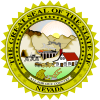 |
| Song | Home Means Nevada | 1933 | |
| Steam locomotive | Nevada Northern Railway #40 | 2009 |  |
| Type | Symbol | Year | [1] |
|---|---|---|---|
| Flower | Sagebrush (Artemisia tridentata) | 1917 |  |
| Tree | Great Basin Bristlecone pine (Pinus longaeva) | 1987 | 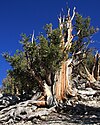 |
| Single-leaf Piñon (Pinus monophylla) | 1959 |  | |
| Grass | Indian ricegrass (Eriocoma hymenoides) | 1977 |  |
| Type | Symbol | Year | Image |
|---|---|---|---|
| Bird | Mountain bluebird (Sialia currucoides) | 1967 |  |
| Animal | Desert bighorn sheep (Ovis canadensis nelsoni) | 1973 |  |
| Fish | Lahontan cutthroat trout (Oncoryhnchus clarki henshawi) | 1981 |  |
| Fossil | Ichthyosaur (Shonisaurus popularis) [2] [3] | 1977 |  |
| Reptile | Desert tortoise (Gopherus agassizii) | 1989 |  |
| Insect | Vivid Dancer Damselfly (Argia vivida) [4] | 2009 |  |
| Type | Symbol | Year | Image |
|---|---|---|---|
| Mineral | Silver | 1977 |  |
| Rock | Sandstone | 1987 |  |
| Soil | Orovada | 2001 |
| Type | Symbol | Year | Images |
|---|---|---|---|
| Color | Blue and Silver [5] | ||
| Song | Home Means Nevada | 1933 | |
| Steam locomotive | Nevada Northern Railway #40 | 2009 |  |

Shonisaurus is a genus of very large ichthyosaurs. At least 37 incomplete fossil specimens of the marine reptile have been found in the Luning Formation of Nevada, USA. This formation dates to the late Carnian age of the late Triassic period, about 237–227 million years ago.
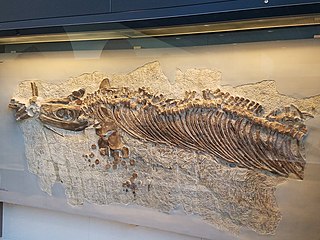
Cymbospondylus was a basal early ichthyosaur that lived between the early and middle Triassic period. Previously, the genus was classified as a shastasaurid, but more recent work finds it to be more basal. Cymbospondylus was a cosmopolitan genus found in Nevada, Europe and Spitsbergen.
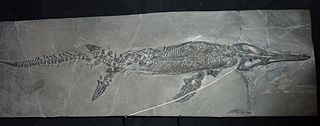
Mixosaurus is an extinct genus of Middle Triassic ichthyosaur. Its fossils have been found near the Italy–Switzerland border and in South China.

Omphalosaurus is an extinct genus of marine reptile from the Early Triassic to Middle Triassic, thought to be in the order of Ichthyosauria. Most of what is known about Omphalosaurus is based on multiple jaw fragments, ribs, and vertebrae. Specimens of Omphalosaurus have been described from the western United States, Poland, Austria and the island of Spitsbergen off the northern coast of Norway.

Berlin–Ichthyosaur State Park is a public recreation area and historic preserve that protects undisturbed ichthyosaur fossils and the ghost town of Berlin in far northwestern Nye County, Nevada. The state park covers more than 1,100 acres (450 ha) at an elevation of 7,000 feet (2,100 m) on the western slope of central Nevada's Shoshone mountain range, 23 miles (37 km) east of Gabbs. The park has Bortle scale class 1 skies which makes the state park a great place for astronomy as it is far away from light pollution.

Phalarodon is an extinct genus of mixosaurid ichthyosaur known from the Middle Triassic. Its name is derived from the Greek φάλαρα (phálara) and odon ("tooth"). The genus has had a tumultuous history since its classification in 1910, with different workers describing species under different genera or declaring the genus to be a nomen dubium. Currently three species are recognized, but more have been identified in the past.
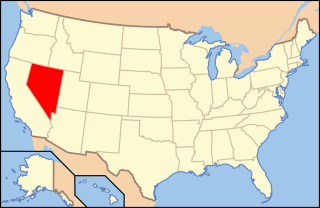
Paleontology in Nevada refers to paleontological research occurring within or conducted by people from the U.S. state of Nevada. Nevada has a rich fossil record of plants and animal life spanning the past 650 million years of time. The earliest fossils from the state are from Esmeralda County, and are Late Proterozoic in age and represent stromatolite reefs of cyanobacteria, amongst these reefs were some of the oldest known shells in the fossil record, the Cloudina-fauna. Much of the Proterozoic and Paleozoic fossil story of Nevada is that of a warm, shallow, tropical sea, with a few exceptions towards the Late Paleozoic. As such many fossils across the state are those of marine animals, such as trilobites, brachiopods, bryozoans, honeycomb corals, archaeocyaths, and horn corals.

This timeline of ichthyosaur research is a chronological listing of events in the history of paleontology focused on the ichthyosauromorphs, a group of secondarily aquatic marine reptiles whose later members superficially resembled dolphins, sharks, or swordfish. Scientists have documented ichthyosaur fossils at least as far back as the late 17th century. At that time, a scholar named Edward Lhwyd published a book on British fossils that misattributed some ichthyosaur vertebrae to actual fishes; their true nature was not recognized until the 19th century. In 1811, a boy named Joseph Anning discovered the first ichthyosaur fossils that would come to be scientifically recognized as such. His sister Mary would later find the rest of its skeleton and would go on to become a respected fossil collector and paleontologist in her own right.
Margaret Marean Wheat was an American anthropologist, archeologist and paleontologist who worked and made significant contributions in the Great Basin, in North America.